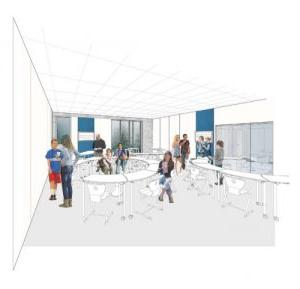Against the Tidy Classroom
By Kristin Belz
Date
September 8, 2016Picture a K-12 school classroom, and you probably see an array of chairs and desks all in rows, facing the front of the classroom. But think about it: is that the best way for children to learn? Should there even be a “front” of a classroom? More and more, educators today agree that teaching should be student-oriented, not teacher-oriented. They’re rethinking how they set up their classrooms.

Hockinson Middle School Classroom Pod Concept
The Superintendent and teachers at Hockinson Middle School, in Brush Prairie, Washington, explored a classroom layout (as seen to the left) that went beyond the typical old model of rectangular classrooms with a hierarchical “front” occupied by the teacher; they understood that students do not need to be facing the same direction to be moving forward along the same learning path. Instead of a single classroom teaching wall, the new Hockinson being designed by our Portland studio, DOWA-IBI Group Architects, will have three collaborative surfaces per classroom, each designed to support the varied ways students might collaborate and learn together and comprised of floor-to-ceiling whiteboard, tackable surface, and flat-screen monitor. Seating for students will be grouped into three circular “pods” of desks, so they may work together easily. Teachers will have a desk in the corner of the room, but will be able to move about, touching base with students easily, while students remain focused on individual, small group, or collective learning activities. The whole set-up will be fluid yet organized.
In fact, a recent UK study noted that the ability of students and teachers to be able to tailor their environment—to change it according to their needs—was a key to improving students’ learning outcomes. The study was carried out by IBI Learning+ in support of the University of Salford, and published in “Clever Classrooms.” One of its key findings was that the design of the individual classroom was far more important than the design of the overall school. Individualization, flexibility, and control of the physical environment were among the qualities identified as being most important to improving learning outcomes of the students.
Second grade teacher Kayla Delzer challenges us, in a column in Edutopia, maintaining that “To see that some classrooms look the same now as they did 70 years ago is shameful.” As an alternative to the rigid old seating chart model, she suggests a comfortable, varied, and variable environment, something with more seating types, areas, and choices—something more like a Starbucks: “When you walk into Starbucks, you have a choice. You get to choose where you sit. No one checks you in and directs you to a spot, telling you that you must sit there for the remainder of the day to do your work.”
Of course, you don’t have to make a classroom look like a café to successfully make improvements to the out-of-date rigid classroom model. Many educators have simple, implementable suggestions for making meaningful changes.
- “Rethink the box” – Lisa Nielsen proposes that we ask ourselves “what does your classroom invite students to do?” She recommends that every classroom include four types of spaces: private, alone; public, alone; private, together; public, together.
- Organize the classroom into seven “zones” – Veronica Lopez creates a system of specific spaces that encourage and organize the range of activities that need to happen in the K-12 classroom: discovery, news, supplies, community, quiet, teacher, and subject area.
- Create a deskless classroom – Tracy Evans wonders, “What if, instead of making our space for our students, we made it with our students?” She has used the “Design Thinking” process to do so with her young students, engaging them in the process of re-imagining their own spaces and thus literally engaging them in the classroom activity from the very first day of the school year.
It is tantalizing to think about what can happen as classrooms break out of the box. What if our own school experiences had been different? Many of us spent years in that classroom box, sitting in a typical desk-in-a-row facing front. Were you assigned seats alphabetically by last name, as some of us were? What effect would being a “B,” for instance, have, on a shy child? Would she thrive there, sitting in the first row along the side wall of the room—or would she have been better off sitting in the middle of the room, where the “L” and “M” and “R” kids were, surrounded by cohorts?
Would a different classroom configuration have enabled each of us to thrive sooner or more fully? We know now that not all students are the same, nor do they learn in the same ways. It’s exciting to aspire to creating classrooms and spaces that can accommodate and encourage different learning styles.







